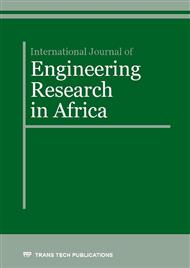[1]
N. Amjady, and M. Esmaili,: Application of a New Sensitivity Analysis Framework for Voltage Contingency Ranking , IEEE Transactions on Power Systems, , May 2005, p.973-983Vol. 20, Issue 2.
DOI: 10.1109/tpwrs.2005.846088
Google Scholar
[2]
V. Donde, V. López, B. Lesieutre, A. Pinar, C. Yang, and J. Meza, : Severe Multiple Contingency Screening in Electric Power Systems, IEEE Transactions On Power Systems, May 2008, pp.406-417, Vol. 23, ( 2).
DOI: 10.1109/tpwrs.2008.919243
Google Scholar
[3]
G.J. Lopez, J.W. Gonzalez, A.E. Diez, I.A. Isaac, H.A. Cardona, R.A. Leon, : Contingency Analysis Model of Electrical Power Systems Based on Central Angles from PMUs , September 2013, Power, Energy Materials and Engineering Applications, Chapter 7.
DOI: 10.4028/www.scientific.net/amr.772.664
Google Scholar
[4]
Sergey Aleksandrovich Gusev,: Estimation of Significant Number of Simultaneously Failed Elements during Power System Security Calculations, Power System, Control and Automation, June 2014, Chapter 9.
DOI: 10.4028/www.scientific.net/amr.960-961.1112
Google Scholar
[5]
Bi Qiang Tang, Yi Jun Yu, Shu Hai Feng, Feng Li, : A Novel Method of Static Security Analysis Based on Multithread Technology, Power System, Control and Automation, August 2013, Chapter 5.
Google Scholar
[6]
M. Abedi, M. Ehsan, Z. G. Jahromi, M. M. Jamei,: Utilization of Analytical Hierarchy Process in Contingency Ranking, March 2009, pp.1-6 Power Systems Conference and Exposition, PSCE '09, Seattle, WA.
DOI: 10.1109/psce.2009.4839971
Google Scholar
[7]
W. Qin, P. Wang, X. Han, and X. Du, : Reactive Power Aspects in Reliability Assessment of Power Systems, February 2011, pp.85-92, IEEE Transactions on Power Systems, Vol. 26, Issue 1.
DOI: 10.1109/tpwrs.2010.2050788
Google Scholar
[8]
V. Krishnan, J. D. McCalley,: Contingency assessment under uncertainty for voltage collapse and its application in risk based contingency ranking , Electrical Power and Energy Systems, Vol. 43.
DOI: 10.1016/j.ijepes.2012.05.065
Google Scholar
[9]
H. Chiang, W. Lei, Toward Real-Time Detection of Critical Contingency of Large Power Systems, Power and Energy Society General Meeting (PES), 2012, Pg 1025–1033, Vancouver, BC, July 2013, pp.1-5.
DOI: 10.1109/pesmg.2013.6672366
Google Scholar
[10]
A. Lashkar Ara, J. Aghaei, M. Alaleh, H. Barati, : Contingency-based optimal placement of Optimal Unified Power Flow Controller (OUPFC) in electrical energy transmission systems, Vol. 20 (3), p.778–785, Scientia Iranica, (2013).
DOI: 10.1016/j.enconman.2010.09.030
Google Scholar
[11]
M. Moazzami, R. A. Hooshmand, A. Khodabakhshian, And M. Yazdanpanah, : Blackout Prevention in Power System Using Flexible AC Transmission System Devices and Combined Corrective Actions, Electric Power Components and Systems, Vol. 41, p.1433–1455, (2013).
DOI: 10.1080/15325008.2013.830655
Google Scholar
[12]
K. Visakha, D. Thukaram, L. Jenkins,: Application of UPFC for system security improvement under normal and network contingencies, 2004, p.46–55, Electric Power Systems Research, Vol. 70.
DOI: 10.1016/j.epsr.2003.11.011
Google Scholar
[13]
V. Jayasankara, N. Kamaraj b, N. Vanaja,: Estimation of voltage stability index for power system employing artificial neural network technique and TCSC placement, Neurocomputing, Vol. 73, 2010, p.3005–3011.
DOI: 10.1016/j.neucom.2010.07.006
Google Scholar
[14]
H. I. Shaheen, G. I. Rashed, S.J. Cheng,: Application and comparison of computational intelligence techniques for ptimal location and parameter setting of UPFC, Engineering Applications of Artificial Intelligence, Vol. 23, 2010, p.203–216.
DOI: 10.1016/j.engappai.2009.12.002
Google Scholar
[15]
H. I. Shaheen, G. I. Rashed, S.J. Cheng, : Optimal location and parameter setting of UPFC for enhancing power system security based on Differential Evolution algorithm, Electrical Power and Energy Systems, Vol. 33, 2011, p.94–105.
DOI: 10.1016/j.ijepes.2010.06.023
Google Scholar
[16]
A. Tiwari,: Optimal Allocation of Dynamic VAR Support Using Mixed Integer Dynamic Optimization, IEEE Transactions On Power Systems, Vol. 26, No. 1, February 2011, pp.305-314.
DOI: 10.1109/tpwrs.2010.2051342
Google Scholar
[17]
S. Varshney L. Srivastava, M. Pandit, : Optimal location and sizing of STATCOM for Voltage Security Enhancement using PSO-TVAC, International Conference on Power and Energy Systems (ICPS), 2011, Chennai, Dec. 2011, pp.1-6.
DOI: 10.1109/icpes.2011.6156646
Google Scholar
[18]
N. G. Hingorani and L. Gyugyi,: Understanding FACTS: Concepts and Technology of Flexible AC Transmission System, IEEE Press, (2000).
Google Scholar
[19]
A. Mishra, G. V. Nagesh Kumar, : Line utilisation factor-based optimal allocation of IPFC and sizing using firefly algorithm for congestion management, IET Generation, Transmission & Distribution, 2016, Vol. 10, Iss. 1, p.115–122.
DOI: 10.1049/iet-gtd.2015.0493
Google Scholar


